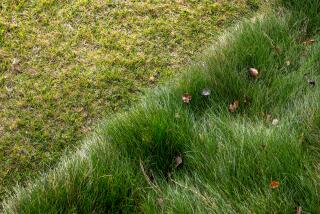GARDENING : Give Lawn a Treat With Proper Fertilizers, Watering
- Share via
Natural fertilizers, made of bone meal, blood meal, feathers, seaweed, fish byproducts, bat droppings, ash from sunflower seed hulls and a variety of other substances are becoming increasingly popular. Most of these packaged fertilizers also include nitrogen-converting microbes.
Conventional inorganic fertilizers exist in a ready nitrate state. The moment you add water, the nutrients can be absorbed by plant roots.
Organic fertilizer, in contrast, must first be converted, by microbes in the soil, from an organic to an inorganic state. The microbes actually produce the nitrates.
As this process takes place deeper in the soil, the nitrates are not as exposed to surface runoff. This is not to say that nitrates from organic material cannot be eroded from the soil, or leached downward through sandy soil, but the problem is a lesser one. Because nutrients are released slowly, organic fertilizers can be applied any time throughout the year.
Another option is to treat your lawn with an enzyme-activated soil conditioner, such as Nitron Formula A-35.
Research indicates that by increasing certain beneficial enzymes in the soil, water tension factors are altered, and the soil is made more water permeable and absorbent. As such, waterborne nutrients are more easily accessed by plant roots, and soil compaction is reduced.
The only way to check for proper pH is with a soil test. You can call a professional or take a soil sample into your local lab, extension office or university.
Home testing kits are also available through catalogues and garden centers. An alkaline soil will need an application of sulfur or gypsum, while acidic soils will benefit from a sprinkling of lime.
Turf grasses do best within a pH range of 5.6 to 7, and your extension agent or dealer will know which treatment plan is best for your lawn.
As for watering, it’s always best to water more deeply and less often.
To hold down fungi-related leaf blight, water in the morning so that the grass dries quickly. Avoid evening watering.






